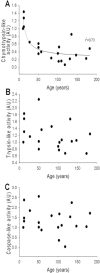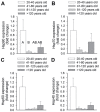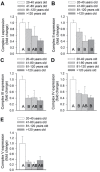A heart that beats for 500 years: age-related changes in cardiac proteasome activity, oxidative protein damage and expression of heat shock proteins, inflammatory factors, and mitochondrial complexes in Arctica islandica, the longest-living noncolonial animal
- PMID: 24347613
- PMCID: PMC4271020
- DOI: 10.1093/gerona/glt201
A heart that beats for 500 years: age-related changes in cardiac proteasome activity, oxidative protein damage and expression of heat shock proteins, inflammatory factors, and mitochondrial complexes in Arctica islandica, the longest-living noncolonial animal
Abstract
Study of negligibly senescent animals may provide clues that lead to better understanding of the cardiac aging process. To elucidate mechanisms of successful cardiac aging, we investigated age-related changes in proteasome activity, oxidative protein damage and expression of heat shock proteins, inflammatory factors, and mitochondrial complexes in the heart of the ocean quahog Arctica islandica, the longest-lived noncolonial animal (maximum life span potential: 508 years). We found that in the heart of A. islandica the level of oxidatively damaged proteins did not change significantly up to 120 years of age. No significant aging-induced changes were observed in caspase-like and trypsin-like proteasome activity. Chymotrypsin-like proteasome activity showed a significant early-life decline, then it remained stable for up to 182 years. No significant relationship was observed between the extent of protein ubiquitination and age. In the heart of A. islandica, an early-life decline in expression of HSP90 and five mitochondrial electron transport chain complexes was observed. We found significant age-related increases in the expression of three cytokine-like mediators (interleukin-6, interleukin-1β, and tumor necrosis factor-α) in the heart of A. islandica. Collectively, in extremely long-lived molluscs, maintenance of protein homeostasis likely contributes to the preservation of cardiac function. Our data also support the concept that low-grade chronic inflammation in the cardiovascular system is a universal feature of the aging process, which is also manifest in invertebrates.
Keywords: Cardiac.; Extreme longevity; Invertebrate; Model system; Mollusc.
© The Author 2013. Published by Oxford University Press on behalf of The Gerontological Society of America. All rights reserved. For permissions, please e-mail: journals.permissions@oup.com.
Figures






Similar articles
-
Extreme longevity is associated with increased resistance to oxidative stress in Arctica islandica, the longest-living non-colonial animal.J Gerontol A Biol Sci Med Sci. 2011 Jul;66(7):741-50. doi: 10.1093/gerona/glr044. Epub 2011 Apr 12. J Gerontol A Biol Sci Med Sci. 2011. PMID: 21486920 Free PMC article.
-
Resistance to genotoxic stresses in Arctica islandica, the longest living noncolonial animal: is extreme longevity associated with a multistress resistance phenotype?J Gerontol A Biol Sci Med Sci. 2013 May;68(5):521-9. doi: 10.1093/gerona/gls193. Epub 2012 Oct 10. J Gerontol A Biol Sci Med Sci. 2013. PMID: 23051979 Free PMC article.
-
Low hydrogen peroxide production in mitochondria of the long-lived Arctica islandica: underlying mechanisms for slow aging.Aging Cell. 2013 Aug;12(4):584-92. doi: 10.1111/acel.12082. Epub 2013 May 6. Aging Cell. 2013. PMID: 23566066
-
Masters of longevity: lessons from long-lived bivalves--a mini-review.Gerontology. 2010;56(1):55-65. doi: 10.1159/000221004. Epub 2009 May 26. Gerontology. 2010. PMID: 19468199 Review.
-
What modulates animal longevity? Fast and slow aging in bivalves as a model for the study of lifespan.Semin Cell Dev Biol. 2017 Oct;70:130-140. doi: 10.1016/j.semcdb.2017.07.046. Epub 2017 Aug 1. Semin Cell Dev Biol. 2017. PMID: 28778411 Review.
Cited by
-
Novel treatment strategies for chronic kidney disease: insights from the animal kingdom.Nat Rev Nephrol. 2018 Apr;14(4):265-284. doi: 10.1038/nrneph.2017.169. Epub 2018 Jan 15. Nat Rev Nephrol. 2018. PMID: 29332935 Review.
-
Biomimetics - Nature's roadmap to insights and solutions for burden of lifestyle diseases.J Intern Med. 2020 Mar;287(3):238-251. doi: 10.1111/joim.12982. Epub 2019 Oct 22. J Intern Med. 2020. PMID: 31639885 Free PMC article. Review.
-
Pcsk6 Deficiency Promotes Cardiomyocyte Senescence by Modulating Ddit3-Mediated ER Stress.Genes (Basel). 2022 Apr 18;13(4):711. doi: 10.3390/genes13040711. Genes (Basel). 2022. PMID: 35456517 Free PMC article.
-
Resveratrol encapsulated in novel fusogenic liposomes activates Nrf2 and attenuates oxidative stress in cerebromicrovascular endothelial cells from aged rats.J Gerontol A Biol Sci Med Sci. 2015 Mar;70(3):303-13. doi: 10.1093/gerona/glu029. Epub 2014 Mar 18. J Gerontol A Biol Sci Med Sci. 2015. PMID: 24642904 Free PMC article.
-
Nontraditional systems in aging research: an update.Cell Mol Life Sci. 2021 Feb;78(4):1275-1304. doi: 10.1007/s00018-020-03658-w. Epub 2020 Oct 9. Cell Mol Life Sci. 2021. PMID: 33034696 Free PMC article. Review.
References
-
- Ungvari Z, Buffenstein R, Austad SN, Podlutsky A, Kaley G, Csiszar A. Oxidative stress in vascular senescence: lessons from successfully aging species. Front Biosci. 2008;13:5056–5070. - PubMed
-
- Labinskyy N, Csiszar A, Orosz Z, et al. Comparison of endothelial function, O2.- and H2O2 production, and vascular oxidative stress resistance between the longest-living rodent, the naked mole rat, and mice. Am J Physiol. 2006;291:H2698–H2704. - PubMed
Publication types
MeSH terms
Substances
Grants and funding
LinkOut - more resources
Full Text Sources
Other Literature Sources

